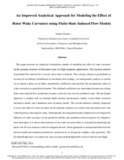JavaScript is disabled for your browser. Some features of this site may not work without it.
| dc.contributor.author | Goulos, Ioannis | |
| dc.date.accessioned | 2021-06-09T15:04:01Z | |
| dc.date.available | 2021-06-09T15:04:01Z | |
| dc.date.issued | 2016-07-01 | |
| dc.identifier.citation | Goulos I. (2016) An improved analytical approach for modeling the effect of rotor wake curvature using finite-state induced flow models. Journal- American Helicopter Society, Volume 61, Issue 3, July 2016, pp. 1-16 | en_UK |
| dc.identifier.issn | 0002-8711 | |
| dc.identifier.uri | https://doi.org/10.4050/JAHS.61.032010 | |
| dc.identifier.uri | https://dspace.lib.cranfield.ac.uk/handle/1826/16750 | |
| dc.description.abstract | This paper presents an analytical formulation capable of modeling the effect of wake curvature on the dynamic response of helicopter rotors for flight dynamics applications. The classical solution of potential flow derived for a curved vortex tube is utilized. The existing solution is generalized to account for an arbitrary distribution of circulatory disk loading. An orthogonality analysis is carried out to obtain a finite set of inflow perturbation coefficients that describe the aerodynamic effect of wake curvature in a generalized manner. The obtained coefficients are superimposed upon an existing finite-state induced flow model that assumes a skewed, noncurved cylindrical wake. The developed approach is coupled with an unsteady blade element aerodynamics model, a rotor blade structural mechanics model, and a nonlinear rotor dynamics model. The overall method is initially employed to assess the effect of wake curvature on the dynamic response of a small-scale articulated rotor with a flap frequency ratio equal to unity. Subsequently, the integrated model is deployed to investigate the influence of wake curvature on the predicted stability and nonlinear control response of a hingeless rotor helicopter. It is shown that inclusion of the wake curvature effect is essential for predicting the pitch–roll off-axis response of the investigated aircraft. Good agreement is demonstrated between the derived model and nonlinear predictions carried out by resolving the complex wake geometry. The developed approach is an improved, time-accurate method applicable to hover and forward flight. | en_UK |
| dc.language.iso | en | en_UK |
| dc.publisher | Vertical Flight Society | en_UK |
| dc.rights | Attribution-NonCommercial 4.0 International | * |
| dc.rights.uri | http://creativecommons.org/licenses/by-nc/4.0/ | * |
| dc.title | An improved analytical approach for modeling the effect of rotor wake curvature using finite-state induced flow models | en_UK |
| dc.type | Article | en_UK |
Files in this item
The following license files are associated with this item:
This item appears in the following Collection(s)
-
Staff publications (SATM) [4365]

